Chapter 7.2.10
Rotherham
Links Across The Ocean
By Suzanne High
(Webmaster's
Note: Herbert Sanders travelled with Harry Bramhill from Rotherham to
Detroit, USA through
Canada
in 1913.
Whether Harry was a friend, a one-time colleague or a relative, Suzanne
is still researching. The article she wrote for the Rotherham Family
History Society, published in Volume 9 Number 3, the Autumn Edition dated
September 2009, is a wonder look at their experiences as they travelled. Harry
Morton Bramhill was a son of Mathew
and Annis Bramhill. The article is reproduced with the permission of both
the FHS and Suzanne High))
Whilst looking through old photographs and other mementos with my mother
recently, we came across a small, black, leather-bound notebook, containing a
pencilled account of a journey my paternal grandfather had made to the
USA
in 1913. In our headlong rush to
delve back as far as we can, we sometimes forget to look closely at the events
in the lives of our most recent forebears – events that can tell us plenty
about the times they lived through. Although
my grandfather’s description of his time in
America
is a far from complete account, it is a delightful snapshot, which throws up
many intriguing puzzles concerning the stateside
Rotherham
connections, some of which I have solved, some of which will keep me occupied
for a good while longer.
Joseph Sanders and Elizabeth Ketteringham were married in Thornaby,
Yorkshire
in 1885. Their families had moved
from Staffordshire and
Norfolk
respectively, presumably in search of employment.
It was possibly the same need to find work that made Joseph and
Elizabeth
move to
Rotherham
, where Herbert and his sister Edith were born.
By the time of the 1911 census, the family had moved from
38 Alma Road
and were living at 12 Whybourne Grove,
Rotherham. Joseph was a steel smelter, and
Herbert, now 23, was described as a ‘core worker’.
In a period of increasingly high unemployment, I do not know whether
Herbert still had his job in 1913. Emigration
rates were high in the decade before the First 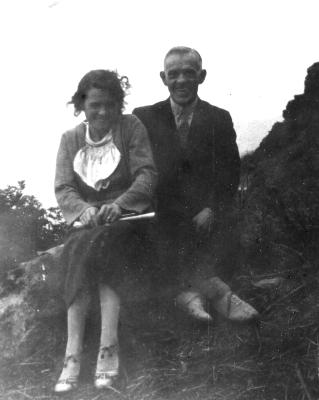 World
War, particularly among males of working age.
Although emigration to New World destinations was free for British
citizens, there were no subsidies at the time for emigration to the
United States
. The fare to the
US
averaged about £5. 7s., which was roughly two weeks wages.
Possibly Herbert was tempted by the prospect of work abroad, or maybe it
was his sense of adventure that persuaded him to leave for
America
.
World
War, particularly among males of working age.
Although emigration to New World destinations was free for British
citizens, there were no subsidies at the time for emigration to the
United States
. The fare to the
US
averaged about £5. 7s., which was roughly two weeks wages.
Possibly Herbert was tempted by the prospect of work abroad, or maybe it
was his sense of adventure that persuaded him to leave for
America
.
Herbert Sanders and Phyllis
Sanders nee Manning
Whatever the reasons, on Tuesday, 22 July 1913, he found himself at the quayside
at
Liverpool
, looking up at the SS Franconia. Built
for the Cunard line in 1911, the Franconia regularly crossed the Atlantic
between Liverpool and
Boston
or New York. On this particular day, it was
bound for Boston
.
Herbert’s jottings veer from the start from observant descriptions of
his surroundings,
‘We
noticed from the start how at first the water at Liverpool was brown and dirty
but as we went along it began to get green till by Thursday morning it was a
very dark blue accounted for by its depth’
to
a typical twenty-odd year-old’s preoccupation with more mundane matters,
‘Thursday morn. Woke up
late. Nearly missed our
breakfast.’
Herbert chose to record his impressions of his adventure in the form of a
letter – but, to whom? His father,
sister, sweetheart? Maybe even my
grandmother, Phyllis Manning, whom Herbert was to marry two years later?
From the surviving pages of his notebook, it is impossible to work out
who Herbert had in his mind’s eye when he sat down to write.
But it is frustratingly clear that whoever it was, he or she knew the
several people that Herbert was to mention by name in his account.
The first of these, Harry, was obviously Herbert’s travelling
companion.
‘While strolling on top deck Thurs morning was startled by Harry
calling ‘There they are’, meaning a shoal of porpoises diving and coming out
of the water’
Clearly, some research was needed, to find out more.
I tried ‘googling’ ‘Cunard passenger lists’, but without success
– there were some lists from Franconia voyages in 1913, but not the particular
sailing that interested me. I had
better luck, though, with ‘www.findmypast.com’.
In their passenger list section, which is a pay-per-view facility, I was
able to key in details of the voyage, and Herbert’s name, and was rewarded
with an entry giving his details. When
every search means using more credits, it is sometimes tempting just to request
a look at the record, rather than the original image, especially as quite often
the two give out identical information. But
this was a demonstration of why it is always better to view the original image
when you can, because, at a cost of 30 credits, I was able to view and download
an image of the original Cunard passenger sheet, which gave me information on
the type of ticket (2nd class), Herbert’s occupation at the time of
travelling (mechanic, but not necessarily in work), countries of departure and
arrival, ticket number (virtually indecipherable), but best of all, the name of
the person (or persons) travelling on the same ticket.
Unfortunately the surname is unclear, but there was enough there,
together with a name mentioned elsewhere in Herbert’s notes (of which, more
later), to confirm that his travelling companion was Harry Bramhill.
Whether Harry was a friend, a one-time colleague or a relative, I had yet
to determine.
After a bout of sea-sickness that kept Herbert confined to his cabin for
a day, he was sufficiently recovered on the Saturday to wax lyrical about the
scenery.
‘We
are watching the waves as they break over each other,
and enjoyed the sight for they look beautiful as the sun shines on them
and makes them sparkle like myriads of diamonds.’
However,
he also had other things to think about.
‘We have nothing to do but chew spearmint.
Wish we had some English fruit.’
Happily,
the two young men did eventually find something to keep them occupied,
‘Time
passed slowly up till Monday when sports were indulged in; fine sport.
Much fun.’
One event on board, witnessed by Herbert, was a grim reminder of the
tragic sinking of the Titanic, which had happened just two years before.
‘A woman on Sunday brought a wreath and threw it on the sea on site of
Titanic in memory of Mr. Stead.’
‘Mr
Stead’ was, presumably, Mr. William Thomas Stead, a well-known journalist,
author, and newspaper proprietor. Mr.
Stead had been travelling on the Titanic to
America
, at the request of the then American president, William Howard Taft, to take
part in a peace congress. The SS
Franconia had been indirectly involved in the rescue of survivors from the
Titanic – the Franconia, just beginning a voyage from Boston to Liverpool, had
stood off Boston Light on the morning of April 15th 1911, relaying
signal information to the port authorities from the SS Carpathia, which was
steaming to New York with 705 Titanic survivors on board.
After eight days at sea, Herbert and Harry arrived in
Boston
at 9 o’clock in the morning of 30th July, 1913.
The arrival of a large ship in
Boston
was always a major event, and hundreds of people would have been at the
quayside in
East Boston
to welcome friends, family and strangers alike.
Herbert and Harry did not have to wait too long before seeing a familiar
face.
‘Sent
baggage beforehand and we were just going to get in the train because we were
told we couldn’t stay above that day, when Tom Malpass came up and managed to
get us off for another day.’
We
are not given any clues as to who Tom Malpass might be, but the 1901 census
shows a Thomas Malpass living with his wife, Elizabeth, and two young sons,
Horace and Willie, at
46 Goose Butt Street, Rawmarsh,
Rotherham
. I could not find the couple in the
1911 census, so perhaps they emigrated to the
USA
? Whoever Thomas was, he wasn’t
the only person in
Boston
known to the two young men, as Herbert wrote,
‘We went to Tommy’s for tea and called in Mrs. Conway.’
There
was time for a stroll around
Boston
, ‘a fine big city with tall
skyscrapers, and houses built of wood’, where my grandfather showed his
Salvation Army background in his description of an Italian funeral,
Strange sight as they saunter along any road as the band plays a straggling tune.
No regular marching whatever’.
Today
we take huge department stores and their contents for granted, but Herbert,
writing in 1913, was struck by the novelty of a certain aspect of one such
building,
‘We
also went into a large general store where you can buy anything for the home.
We went up to the top storey up the stairs.
But we didn’t walk up. They
did that.’
The following day saw Herbert and Harry setting off on the 800 mile train
journey to
Detroit
, their ultimate destination. No
doubt a modern-day journey from
Boston
to
Detroit
would be very different. Herbert
describes a ‘very beautiful’, still-developing country, with mountains and
valleys of pine trees, dense forests and whirling rivers, with ‘here
and there a canoe paddling up the river’ and ‘small
farms of the enterprising emigrants and settlers, where the men were
making clearings for a site for their new home.’
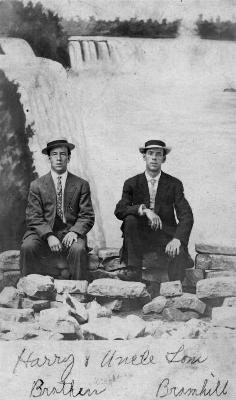 A
glance at a map of North America will show that a direct line from
Boston
to
Detroit
will pass through Canada, and this is roughly the line that the railway followed.
Herbert describes travelling within three miles of
Niagara Falls, and then running alongside the great
Lake St Clair. He was taken aback by
its size.
A
glance at a map of North America will show that a direct line from
Boston
to
Detroit
will pass through Canada, and this is roughly the line that the railway followed.
Herbert describes travelling within three miles of
Niagara Falls, and then running alongside the great
Lake St Clair. He was taken aback by
its size.
‘My!
It was just like looking on the sea itself.
There were lighthouses here and there on its coast at regular intervals
and all kinds of ships sailed its waters.’
From
Windsor,
Canada
, the two men crossed the
Detroit
River
on a large boat train – a ‘transport’, and, finally, arrived in Detroit. Herbert, no doubt thinking about
the
Rotherham
that he had left behind, was impressed with the wide-open spaces of the city
suburbs.
‘What struck me
first was the width of its streets and the space between the houses.
All round every house is a neat plot of lawn.
The houses all have a veranda round for the people to sit on when it’s
too hot to stay indoors. Our house
has a vegetable garden in which are grown tomatoes outside and fine ones they
are too. Water melons also are grown
outside. Inside the house is very
nice with its kitchen, sitting room and parlour.
We have a bath and hot and cold water and a W.C.
(water closet - bathroom) indoors.’
Harry
and Thomas Bramhill at Niagara Falls. Hand writing at the bottom of the
photograph reads: Harry & Uncle Tom, brothers Bramhill.
But, at the risk of sounding like a game-show host, whose house was this?
I had gathered enough information to assume that Herbert’s hosts were
Harry’s relatives – the Bramhills. But
how to find out more about them? Later
on in his narrative, my grandfather talks about a visit he and Harry made, one
Sunday afternoon.
‘Harry
and I went to his late sweetheart’s mother’s for tea at Delray, just outside
Detroit
. We found a nice, homely
Manchester
family. An old man and woman with
two married daughters and husbands and they made us feel quite at home – well,
nearly. We had a grand tea and after
that we had a good sing out of Sankey’s [Sankey’s
being Ira D Sankey’s collection of hymns and songs for concerts and revival
meetings, developed in the late 1800s]
accompanied by me on the piano. We
spent a happy Sunday there. That set
me longing for a piano, and it made Harry talk about getting one.
I don’t know whether he will or not.
However there’s one across at Ted Fishwick’s and I run across there
sometimes and have a tune.’
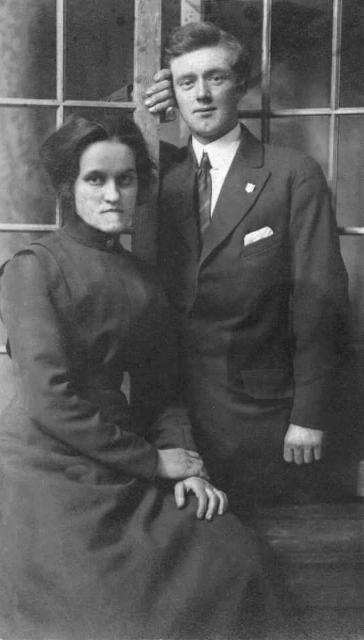 So
here was another first name and surname that I could research.
Without holding out too much hope of success, I keyed ‘Ted Fishwick’
into Google, was directed to www.bramhill.com,
and sat back in amazement as a family history, giving details of generations of
Bramhills and Fishwicks, popped up on the screen.
I have always shied away from posting details of my family tree on the
internet, but I was very grateful that members of the Bramhill and Fishwick
families had decided to share their information with the rest of the world.
Fortunately, when I contacted John Quanz who administers the site, he
very kindly sounded out the relevant members of the Bramhill family, and gave me
permission to use the photographs and information in the website for this
article. Matthew and Annis (nee
Morton) Bramhill were living at
3 Hall Street
, Masbrough at the time of the 1901 census.
On December 13, 1905 they sailed to the
USA
on the SS Oceanic, with their children, Martha, 18, Harry Morton, 16, and
Albert, 2. It seems likely that
their three older children, Gertrude, Thomas and Eliza, were already in the
US
.
So
here was another first name and surname that I could research.
Without holding out too much hope of success, I keyed ‘Ted Fishwick’
into Google, was directed to www.bramhill.com,
and sat back in amazement as a family history, giving details of generations of
Bramhills and Fishwicks, popped up on the screen.
I have always shied away from posting details of my family tree on the
internet, but I was very grateful that members of the Bramhill and Fishwick
families had decided to share their information with the rest of the world.
Fortunately, when I contacted John Quanz who administers the site, he
very kindly sounded out the relevant members of the Bramhill family, and gave me
permission to use the photographs and information in the website for this
article. Matthew and Annis (nee
Morton) Bramhill were living at
3 Hall Street
, Masbrough at the time of the 1901 census.
On December 13, 1905 they sailed to the
USA
on the SS Oceanic, with their children, Martha, 18, Harry Morton, 16, and
Albert, 2. It seems likely that
their three older children, Gertrude, Thomas and Eliza, were already in the
US
.
As
far as I can determine from the copious information given by the descendants of
both families, Thomas Bramhill married Hannah Fishwick, and Gertrude, Thomas’s
sister, married Hannah’s brother, Edmund (Ted) Fishwick.
Herbert could have been staying with Harry’s parents, or at the house
of Harry’s brother, Thomas.
Annie
L. Fishwick and her husband, Walter B. Decarteret
Herbert seems to have found work fairly quickly – perhaps he had the
job lined up before he left for the States.
He was employed at Timken’s Axle Company,
Detroit
.
‘It
is a great fine works employing over 1000 men and the only thing they turn out
is axles for motor cars. The first
job I had was a dirty one, cleaning rings for the hubs with gasoline.
I only had it for six days and then I went on Inspecting.
I got 23 cents an hour, or about 1/- in English money, at 53 hours a
week. I don’t know how long I
shall have it though, as there’s not much work in.
I work days while Harry works nights.
I get up at 5.45 in a morning and have breakfast before I go, and that
does while 11.30, with an hour for lunch and home again at 5pm for dinner.’
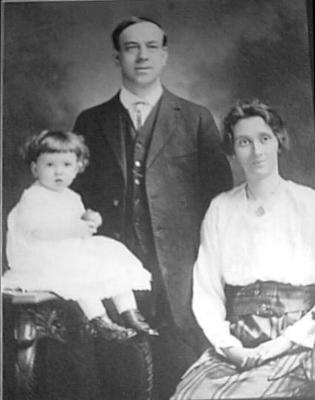 My
grandfather seems to have found the heat of an American summer quite oppressive.
He avoided going out at night, because of the mosquitoes, but was
impressed by the modern ways in which his hosts stayed cool.
My
grandfather seems to have found the heat of an American summer quite oppressive.
He avoided going out at night, because of the mosquitoes, but was
impressed by the modern ways in which his hosts stayed cool.
‘We
have an ice-box at home with great blocks of ice in, on which we keep butter,
milk etc, and a jug of water for me when I come home.
I do enjoy that drink. It is
like drinking ice itself.’
Harry
Morton Bramhill, Bertha Mildred Bramhill
nee
Smith and daughter Ruth May Bramhill
Despite
the heat and his heavy workload, Herbert seems to have found time to explore his
new surroundings, and to socialise with his hosts and their friends.
While he was there, the Bramhills had a visit from a Mr. and Mrs. Herbert
Spencer, from
Chatham
,
Canada
. It is clear from Herbert’s notes
that the Spencers were not only familiar to him, but also to his correspondent,
as he writes, ‘they wish to be
remembered to you’. He
mentions his hosts sending out for two quarts of vanilla and strawberry ice
cream for Annie Fishwick’s birthday party.
Annie was, I think, the daughter of Gertrude (nee Bramhill) and Ted
Fishwick. The Bramhills and
Fishwicks were keen Salvationists. Herbert
describes a Sunday night visit to an Army meeting, about four miles away, but is
scandalised by all the other activities available to be sampled on Sundays.
I
wonder what my mother would think if she saw all the theatres, music halls,
picture places, pubs, restaurants and all the refreshment stores open and all
the noise going on all day through. I
bet she’d be shocked. They even
play football and other games on a Sunday and thousands of people go to see
them. I never went to one on a
Sunday and don’t intend.’
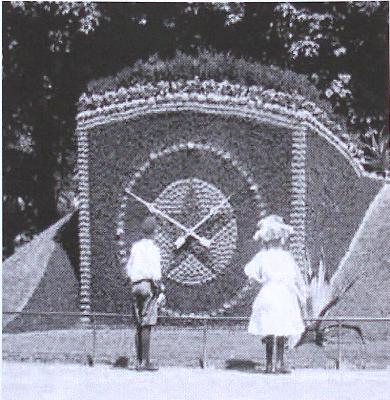 But
he did approve of other ways of relaxing. He
visited Waterworks Park, where the public were allowed in to the engine rooms to
see the giant pumps working, and which featured a floral clock with even the
minutes on the dial made up of flowers and plants, and Belle Isle Park, with its
public conservatory – built entirely of glass domes, and filled with tropical
plants ‘as thick round as a man’s
body’. It was in
Belle
Isle
Park
that he saw his first baseball game, which he found very interesting, but
decided he’d ‘sooner have cricket’.
(This last comment is not surprising.
The other pages of Herbert’s notebook are filled with cricket scores.)
But
he did approve of other ways of relaxing. He
visited Waterworks Park, where the public were allowed in to the engine rooms to
see the giant pumps working, and which featured a floral clock with even the
minutes on the dial made up of flowers and plants, and Belle Isle Park, with its
public conservatory – built entirely of glass domes, and filled with tropical
plants ‘as thick round as a man’s
body’. It was in
Belle
Isle
Park
that he saw his first baseball game, which he found very interesting, but
decided he’d ‘sooner have cricket’.
(This last comment is not surprising.
The other pages of Herbert’s notebook are filled with cricket scores.)
Floral
clock, Waterworks Park, Detroit
He was particularly taken with another aspect of
Detroit
river life – the moonlighters.
‘Short
trips are organised each evening on the large
Detroit
steamers and they sail up and down the river in the moonlight.
They have dancing and music on board and to make it more enticing they
have a number of search-lights with which they light up the most interesting
spots of the coast. There are
thousands go each evening on these trips. It
is very pretty too to watch the boats all lit up from the coast.
As they sail past you can hear the music playing and see in the distance
the dancers as they whirl in and out of the search-light on the decks.
Sadly,
though, Herbert’s stay in the
US
was destined to be short.
‘Comes
the inevitable and work is that slack that many have to give up their jobs, me
included. After a while of thinking
and studying, I made up my mind to come back home.
I should have been out of work for some months and to live with Mrs. Bramhill all that time without giving her anything, well, I couldn’t
do it. Even Harry had to stop
working, in fact all the night shift has gone on the “bum”. I
got my passage from a German agent and all I have to do now is wait till the
good ship “Laconia” sails from
Boston back to England.’
I
have no clues as to the date of Herbert’s return trip on the SS Laconia, other
than the fact that his last week staying with the Bramhills coincided with
Detroit Shopping Week. If I could
find out when the Shopping Week was held, it would narrow down my search of the
passenger lists. I am interested to
know whether Harry Morton Bramhill returned to England
with Herbert. I have found no
evidence that Herbert and Harry were related, and, at the time of the 1901
census, the last one before Harry left with his family for
America
, they were living in different parts of
Rotherham
. I can only presume that they knew
each other from Salvation Army meetings, as my grandfather was obviously a keen
musician, and I know from the Bramhill website that Harry was a Salvation Army
bandsman before he emigrated. Their
friendship must have been strong – stretching across the
Atlantic
and down the years.
My research of this period of my grandfather’s life is very far from complete.
There may be Salvation Army records to investigate, I have passenger
lists to search, and many names to follow up.
Perhaps someone reading this article might be able to provide more
information. But even if I don’t
find out anything more, I am delighted to have found my grandfather’s record
of his visit to the
US
. His first-hand account paints a
vivid picture of a bygone age. Herbert
married my grandmother, Phyllis, in 1915 and they had two sons, Alwyn and my
father, Dennis. Herbert was employed
at Bestobell Valves for the rest of his working life.
I doubt whether he ever left
England
again, or even ventured far from
Rotherham
. If he didn’t, I think I know
why, for, as he puts it,
‘After
all I think, no I’m sure, I like
Rotherham
best of all.’
Suzanne High
If
you have information you can add please contact the webmaster and we will
connect you with Suzanne. Thank you Suzanne for sharing your research and this
part of your grandfather's life with us.
-
End -
 World
War, particularly among males of working age.
Although emigration to New World destinations was free for British
citizens, there were no subsidies at the time for emigration to the
World
War, particularly among males of working age.
Although emigration to New World destinations was free for British
citizens, there were no subsidies at the time for emigration to the  World
War, particularly among males of working age.
Although emigration to New World destinations was free for British
citizens, there were no subsidies at the time for emigration to the
World
War, particularly among males of working age.
Although emigration to New World destinations was free for British
citizens, there were no subsidies at the time for emigration to the 


